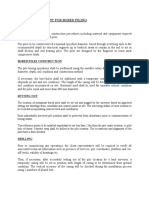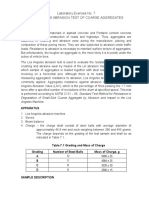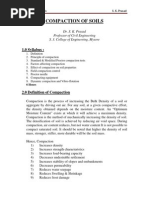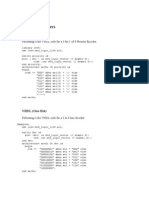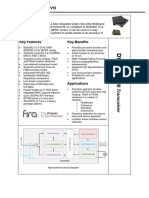100%(1)100% found this document useful (1 vote)
257 viewsCompaction Test
1. The standard proctor compaction test was performed on a fine-grained soil to determine the maximum dry unit weight and optimum moisture content under controlled compaction.
2. Testing involved compacting soil samples prepared at different moisture contents using a standard compaction mold and hammer, then measuring the dry unit weights.
3. The results showed that dry unit weight peaks at the optimum moisture content, as moisture acts as a lubricant up to this point but then replaces soil particles and increases voids at higher contents, reducing density. Establishing this relationship is important for compacting soils in engineering projects.
Uploaded by
Dorn AdamsCopyright
© © All Rights Reserved
Available Formats
Download as DOCX, PDF, TXT or read online on Scribd
100%(1)100% found this document useful (1 vote)
257 viewsCompaction Test
1. The standard proctor compaction test was performed on a fine-grained soil to determine the maximum dry unit weight and optimum moisture content under controlled compaction.
2. Testing involved compacting soil samples prepared at different moisture contents using a standard compaction mold and hammer, then measuring the dry unit weights.
3. The results showed that dry unit weight peaks at the optimum moisture content, as moisture acts as a lubricant up to this point but then replaces soil particles and increases voids at higher contents, reducing density. Establishing this relationship is important for compacting soils in engineering projects.
Uploaded by
Dorn AdamsCopyright
© © All Rights Reserved
Available Formats
Download as DOCX, PDF, TXT or read online on Scribd
You are on page 1/ 5
NAME : DORN ADAMS OYIER
REG NO: E033- 01-1136/2019
COURSE: B.E.D CIVIL ENGINEERING
UNIT: SOIL MECHANICS
TASK: LAB REPORT
TOPIC: COMPACTION TEST
UNIT CODE: ECE 3103
LECTURER: MR. RONOH
ABSTRACT
Soil compaction is one of the most important aspects of any earthwork construction. Compaction
improves the engineering properties of the fills. Nearly all compaction specifications are based on
achieving a certain value of dry unit weight (γd). The static pressure equivalent to the Standard energy
input of a Standard Proctor Test to obtain the Proctor’s optimum moisture content (OMC) and maximum
dry unit weight (MDU) was determined for fine grained soil. The static compaction pressure Test is
performed in the Proctor mould to statically compact the soil at different moisture contents. The standard
proctor compaction test is used in establishing a relationship between moisture content and dry density for
the soil under controlled conditions. In the construction of engineering structures, loose soils must be
compacted to increase their unit weights. Compaction of soil increases the strength of the soils, which
lead to an increase in the bearing capacity of foundations constructed over them. Compaction also
increases the stability of the slopes of embankments and reduces the amount of undesirable settlement of
structures.
INTRODUCTION
The Proctor Compaction Test establishes the maximum unit weight that a particular type of soil can be
compacted to using a controlled compactive force at an optimum water content. This is the most common
laboratory soil test and the basis for all engineered compacted soil placements for embankments,
pavements, and structural fills. The benefits of soil compaction are: Bearing capacity and stability are
increased, Permeability is decreased, heaving from freeze-thaw cycles is reduced, erosion can be
controlled and subsidence is reduced. It has long been known that the moisture content of soils,
particularly cohesive soils, has a direct impact on how efficiently they can be compacted by construction
equipment. But because the soil is a natural material and the ideal moisture content and maximum dry
weight varies for each soil type, the questions of the best unit weight and ideal moisture content couldn’t
be answered. . At very high moisture contents, the maximum dry density is achieved when the soil is
compacted to nearly saturation, where almost all the air is driven out.
At low moisture contents, the soil particles interfere with each other; addition of some moisture will allow
greater bulk densities, with a peak density where this effect begins to be counteracted by the saturation of
the soil. As it is hard to find the exact same soil type with different different moisture contents, samples of
same soil is mixed with water to achieve it.
γbulk = (solid weight of soil inside the mould + moisture weight)/ volume of the mould
(mass of the air within the voids of soil is neglected)
γdry = (solid weight of the sample inside the mould)/ volume of the mould
Moisture content = (water content)/(dry mass of soil) %
It does not increase any further when the moisture content is increased beyond a certain particular value
of the moisture content as the water at this stage starts replacing the soil particles and as the unit weight of
water is less than that of soil particles the density starts decreasing.
AIMS AND OBJECTIVES OF THE EXPERIMENT
1. To obtain the relationship between water content and dry unit weight by using the standard
proctor compaction test.
2. To determine the maximum dry unit weight and optimum water content.
TEST APPARATUS
1. Cylindrical Metal Mold, having internal diameter 10.16cm the internal effective height of 11.7 cm and
the mold should have detachable base plate & collar of 5.08 cm.
2. Rammer, weighing 2.5 kg and having fall of 30.5 cm, with a flat circular face diameter.
3. Sensitive Balance.
4. Thermostatically controlled oven.
5. Steel straight edge.
6. Moisture containers.
7. Sieve No.4.
8. Tray & scoop.
9. Graduated cylinder.
10. Mixing tools. (spoon, trowel, spatula).
11. Water.
12. Soil sample.
PROCEDURE
a) Obtain about 3 kg of soil.
b) Pass the soil through the No. 4 sieve.
c) Weight the soil mass and the mold without the collar (Wm).
d) Place the soil in the mixer and gradually add water to reach the desired moisture content (w).
e) Apply lubricant to the collar.
f) Remove the soil from the mixer and place it in the mold in 3 layers .For each layer, initiate the
compaction process with 25 blows per layer.
g) Carefully remove the collar and trim the soil that extends above the mold with a sharpened
straight edge. Clean outside of the mold & base plate & weigh it.
h) Remove the soil from the mold, split it & take about 100 grams sample for water content
determination.
i) Break the soil lamps, mix it with remaining soil in the tray.
j) Add more water to increase the water content by 2 to 3% & repeat the compaction procedure for
each increment of water until the mass of the compacted soil decreases.
k) Calculate Water content for each trail & corresponding dry density.
OBSERVATIONS AND CALCULATIONS
DISCUSSION
The main purpose of compacting soils is to reduce subsequent settlement under working loads.
Compaction also increases the shear strength of the soil, reduces voids ratio making it more difficult for
water to flow through soil and prevent the buildup of large water pressures that cause soil to liquefy
during earthquakes.
Increasing or decreasing the moisture content from OMC would result in lower dry density. From our
results, it is apparent that the goal was successfully achieved. To be specific, the water acts as a lubricant
to help soil particles move. Decreasing the moisture content would result in a flocculated soil structure,
and increasing it would increase the pore space between particles. Thus, the dry density of the soil will be
lower. The dry density vs. moisture content curve obtained is not as obvious as what is suggested in the
lab manual, but the objective of this experiment is to determine the optimum moisture content and
maximum dry density of a soil specimen using the standard Proctor compaction test. There is nothing new
and unexpected. Besides the error that might be caused by the equipment, soil must be air-dry in different
condition by several groups. Also, when compacting soil, there may be discrepancies. For this exercise,
all groups followed the procedure strictly and received good quality of data with no strength and
weakness found. In comparison with the other results from other groups, the values obtained are in the
middle of the set of data. All the data seems to be good quality, which means data collected from every
group falls into the reasonable range.
Compaction also has effect on hydraulic conductivity and strength. As the soil increases its unit weight by
compaction, the hydraulic conductivity decreases because the pore spaces are taken by soil particles. The
minimum hydraulic conductivity occurs at the optimum moisture content. Beyond the optimum moisture
content, the hydraulic conductivity increases because the pore spaces are taken by water instead of the
soil particles. Compaction increases the strength of soils if compacted on the dry side of the optimum
because of the increase in dry unit weight, thus, its bearing capacity and decreases the potential settlement
of structures built on the soil. The opposite happens if the soil is compacted on the wet side of the
optimum.
POSSIBLE SOURCES OF ERRORS
Possible sources of errors include, wrong measures of samples, improper reading and recording of the
data, wrong interpretation of graphs and incorrect calibration of instruments used. The discrepancy
between the observed and estimated values can reduced in future by eliminating all possible sources of
errors.
CONCLUSION
Ultimately compaction is depending on the void ratio of soil. Compaction is a factor of practical
importance is the increase of soil strength and stability. Nowadays in urban area land is one of the most
common problems. In such cases if soil’s engineering properties is not up to the requirement then there is
no meaning for that project. So in that case soil compaction can be applied as a one of the most economic
ground improvement technique
REFFERENCES
1. An INTRODUCTION TO Geotechnical Engineering by Robert D. Holtz and William D. Kovacs
2. BASIC SOIL MECHANICS Third Edition by R. WHITLOW.
3. PRINCIPLES OF GEOTECHNICAL ENGINEERING by BRAJA M. DAS and KHALED
SOBHAN.
4. Problem Solving in Soil Mechanics By A. AYSEN
You might also like
- CMPM Reviewer Quiz 1: It Means The Demolition of A Structure Done With Some Equipment Without The Use of Any ExplosiveNo ratings yetCMPM Reviewer Quiz 1: It Means The Demolition of A Structure Done With Some Equipment Without The Use of Any Explosive3 pages
- Assignment Top Sheet Department of Civil Engineering & TechnologyNo ratings yetAssignment Top Sheet Department of Civil Engineering & Technology6 pages
- 3.1) Soil Compaction - Methods, Tests and EffectNo ratings yet3.1) Soil Compaction - Methods, Tests and Effect18 pages
- Ch7b Quality Control in Construction of EmbankmentsNo ratings yetCh7b Quality Control in Construction of Embankments8 pages
- DIV 2-SITE WORK Sec 02210-Compaction and Testing of EarthworkNo ratings yetDIV 2-SITE WORK Sec 02210-Compaction and Testing of Earthwork4 pages
- Estimate For: Construction of Security Wall, Hut and Gate at 220KV S/S Sadh, KanpurNo ratings yetEstimate For: Construction of Security Wall, Hut and Gate at 220KV S/S Sadh, Kanpur8 pages
- Determination of Aggregate Crushing ValueNo ratings yetDetermination of Aggregate Crushing Value9 pages
- Comparison Between Manual Calculation and Software Calculation of G+5 Building Using Staad ProNo ratings yetComparison Between Manual Calculation and Software Calculation of G+5 Building Using Staad Pro5 pages
- Soil Investigation Works Method StatementNo ratings yetSoil Investigation Works Method Statement5 pages
- 2 - Deep Compaction of Cohesionless SoilsNo ratings yet2 - Deep Compaction of Cohesionless Soils24 pages
- LAB 14-California Bearing Ratio (Level 0) WEEK 13No ratings yetLAB 14-California Bearing Ratio (Level 0) WEEK 138 pages
- 1405 BOQ For Package I (Clause 7i of Special Conditions of Contract)No ratings yet1405 BOQ For Package I (Clause 7i of Special Conditions of Contract)27 pages
- Method Statement Crack Repair by Gravity Feed With Cikopoxy CFNo ratings yetMethod Statement Crack Repair by Gravity Feed With Cikopoxy CF2 pages
- Method Statement of Backfilling and CompactionNo ratings yetMethod Statement of Backfilling and Compaction30 pages
- BRT-Peshawer-Package-I-Reach-I - METHOD STATEMENTNo ratings yetBRT-Peshawer-Package-I-Reach-I - METHOD STATEMENT66 pages
- Lecture Presentation 1 - Materials and Aggregates100% (1)Lecture Presentation 1 - Materials and Aggregates68 pages
- 8670-Nesco Exhibition Hall No-08-Boq-R2 PDFNo ratings yet8670-Nesco Exhibition Hall No-08-Boq-R2 PDF13 pages
- Gantt Chart - Project Management - Christal WongNo ratings yetGantt Chart - Project Management - Christal Wong3 pages
- ECE 3101 Transport Planning I Lecture 1No ratings yetECE 3101 Transport Planning I Lecture 113 pages
- ECE 3101 Transportation Planning I: Lecturer: M. NgariNo ratings yetECE 3101 Transportation Planning I: Lecturer: M. Ngari26 pages
- Design of Long Span Concrete Box Girder Bridges: Challenges and SolutionsNo ratings yetDesign of Long Span Concrete Box Girder Bridges: Challenges and Solutions11 pages
- Handling Precautions: Butterfly Valves (Common To All Models)No ratings yetHandling Precautions: Butterfly Valves (Common To All Models)9 pages
- (David Matsumoto) The Handbook of Culture and Psyc (B-Ok - Xyz) PDF100% (1)(David Matsumoto) The Handbook of Culture and Psyc (B-Ok - Xyz) PDF475 pages
- K.S.K Academy Sr. Sec. Public School: Digital FileNo ratings yetK.S.K Academy Sr. Sec. Public School: Digital File35 pages
- Chapter 6 Functions: For Educational Purpose Only. Not To Be Circulated Without This BannerNo ratings yetChapter 6 Functions: For Educational Purpose Only. Not To Be Circulated Without This Banner132 pages
- Infrastructure As A Service (Iaas) : A Comparative Performance Analysis of Open-Source Cloud PlatformsNo ratings yetInfrastructure As A Service (Iaas) : A Comparative Performance Analysis of Open-Source Cloud Platforms6 pages
- Web Dynpro ABAP - OTR Text Translation ToolNo ratings yetWeb Dynpro ABAP - OTR Text Translation Tool10 pages
- Organic Chemistry Assignment-1: Complex Question SETNo ratings yetOrganic Chemistry Assignment-1: Complex Question SET6 pages
- Operating System and Memory: Presentation OnNo ratings yetOperating System and Memory: Presentation On31 pages
- CMPM Reviewer Quiz 1: It Means The Demolition of A Structure Done With Some Equipment Without The Use of Any ExplosiveCMPM Reviewer Quiz 1: It Means The Demolition of A Structure Done With Some Equipment Without The Use of Any Explosive
- Assignment Top Sheet Department of Civil Engineering & TechnologyAssignment Top Sheet Department of Civil Engineering & Technology
- Ch7b Quality Control in Construction of EmbankmentsCh7b Quality Control in Construction of Embankments
- DIV 2-SITE WORK Sec 02210-Compaction and Testing of EarthworkDIV 2-SITE WORK Sec 02210-Compaction and Testing of Earthwork
- Estimate For: Construction of Security Wall, Hut and Gate at 220KV S/S Sadh, KanpurEstimate For: Construction of Security Wall, Hut and Gate at 220KV S/S Sadh, Kanpur
- Comparison Between Manual Calculation and Software Calculation of G+5 Building Using Staad ProComparison Between Manual Calculation and Software Calculation of G+5 Building Using Staad Pro
- 1405 BOQ For Package I (Clause 7i of Special Conditions of Contract)1405 BOQ For Package I (Clause 7i of Special Conditions of Contract)
- Method Statement Crack Repair by Gravity Feed With Cikopoxy CFMethod Statement Crack Repair by Gravity Feed With Cikopoxy CF
- ECE 3101 Transportation Planning I: Lecturer: M. NgariECE 3101 Transportation Planning I: Lecturer: M. Ngari
- Design of Long Span Concrete Box Girder Bridges: Challenges and SolutionsDesign of Long Span Concrete Box Girder Bridges: Challenges and Solutions
- Handling Precautions: Butterfly Valves (Common To All Models)Handling Precautions: Butterfly Valves (Common To All Models)
- (David Matsumoto) The Handbook of Culture and Psyc (B-Ok - Xyz) PDF(David Matsumoto) The Handbook of Culture and Psyc (B-Ok - Xyz) PDF
- K.S.K Academy Sr. Sec. Public School: Digital FileK.S.K Academy Sr. Sec. Public School: Digital File
- Chapter 6 Functions: For Educational Purpose Only. Not To Be Circulated Without This BannerChapter 6 Functions: For Educational Purpose Only. Not To Be Circulated Without This Banner
- Infrastructure As A Service (Iaas) : A Comparative Performance Analysis of Open-Source Cloud PlatformsInfrastructure As A Service (Iaas) : A Comparative Performance Analysis of Open-Source Cloud Platforms
- Organic Chemistry Assignment-1: Complex Question SETOrganic Chemistry Assignment-1: Complex Question SET






















